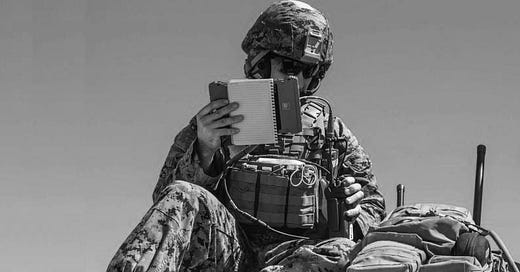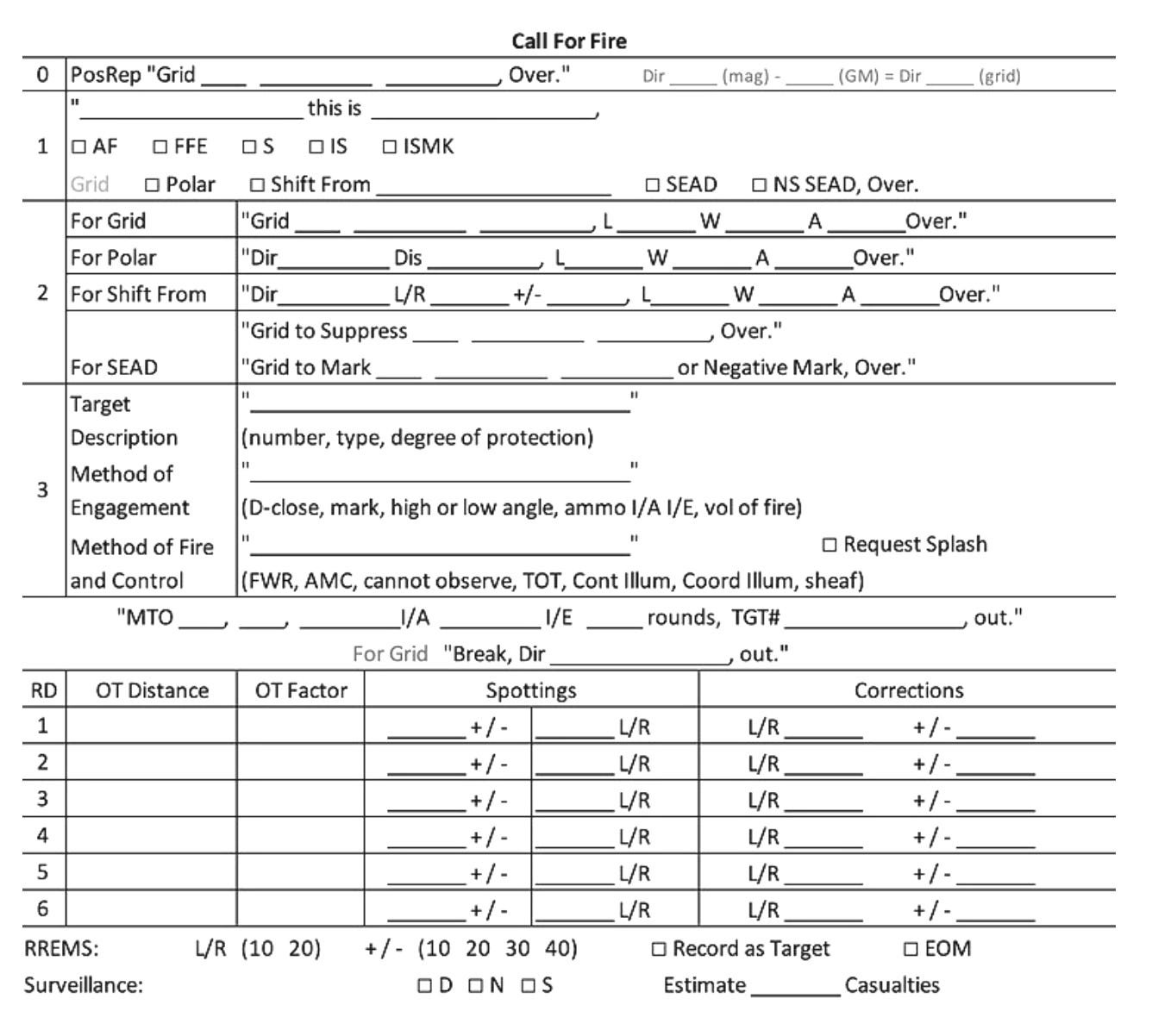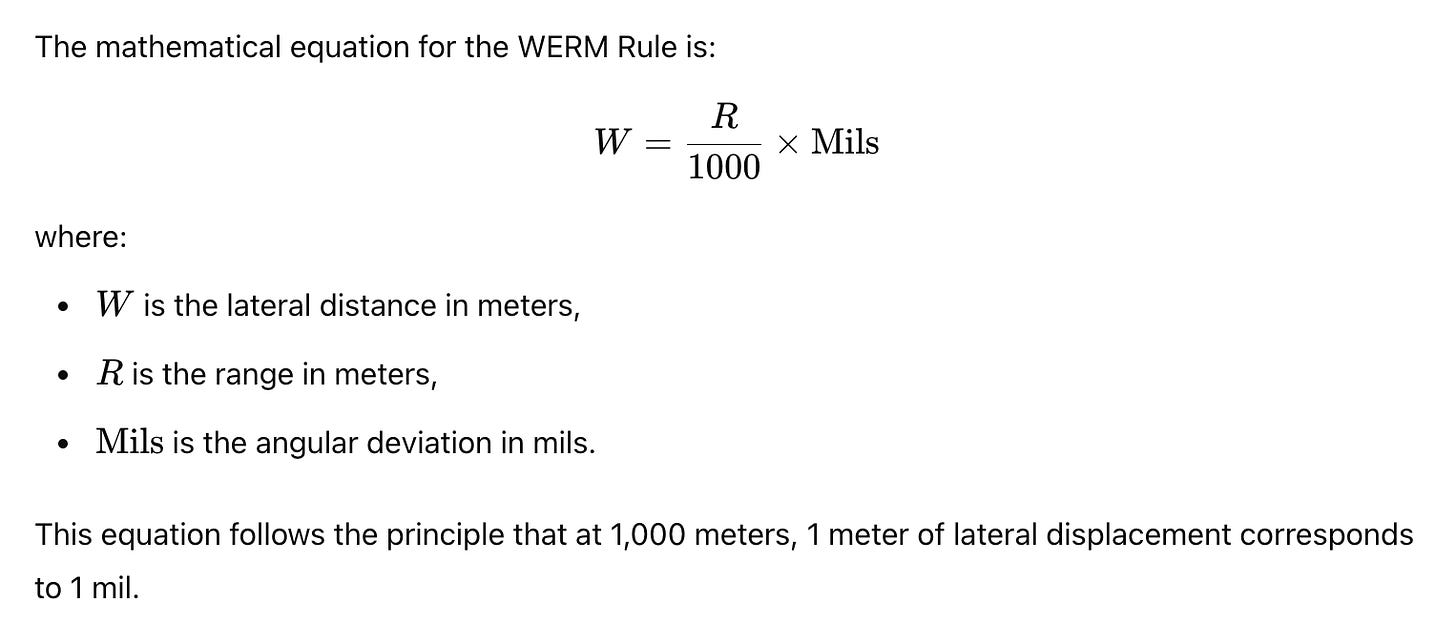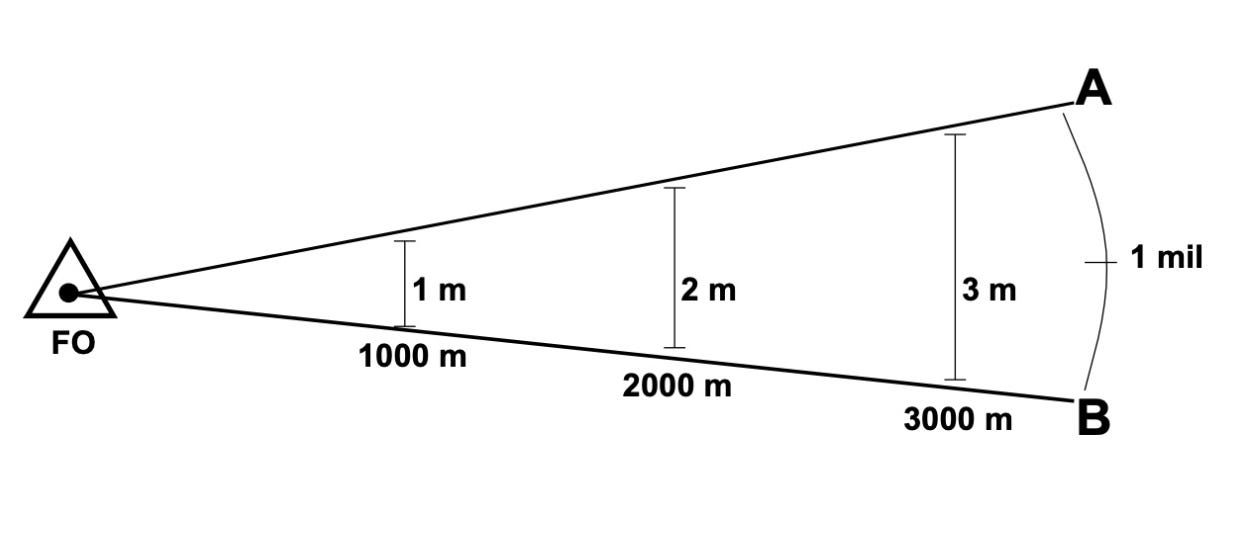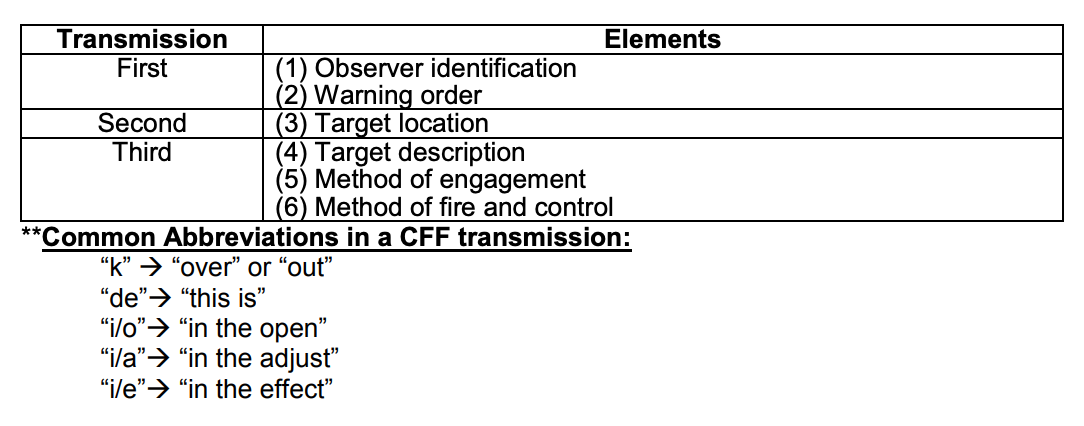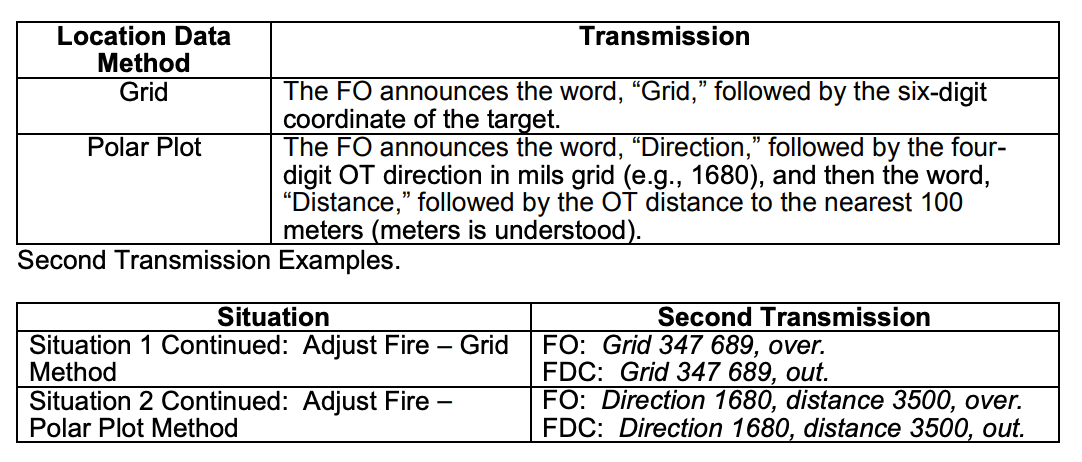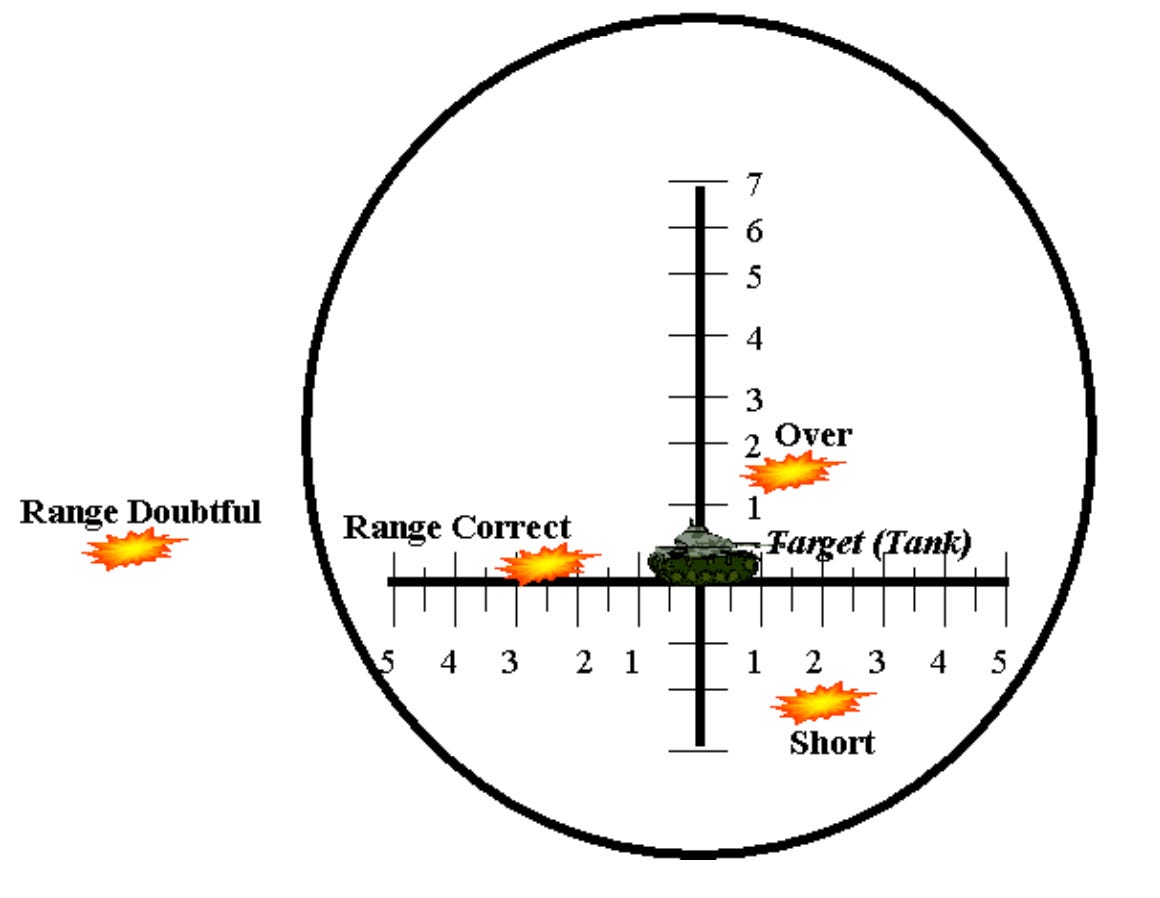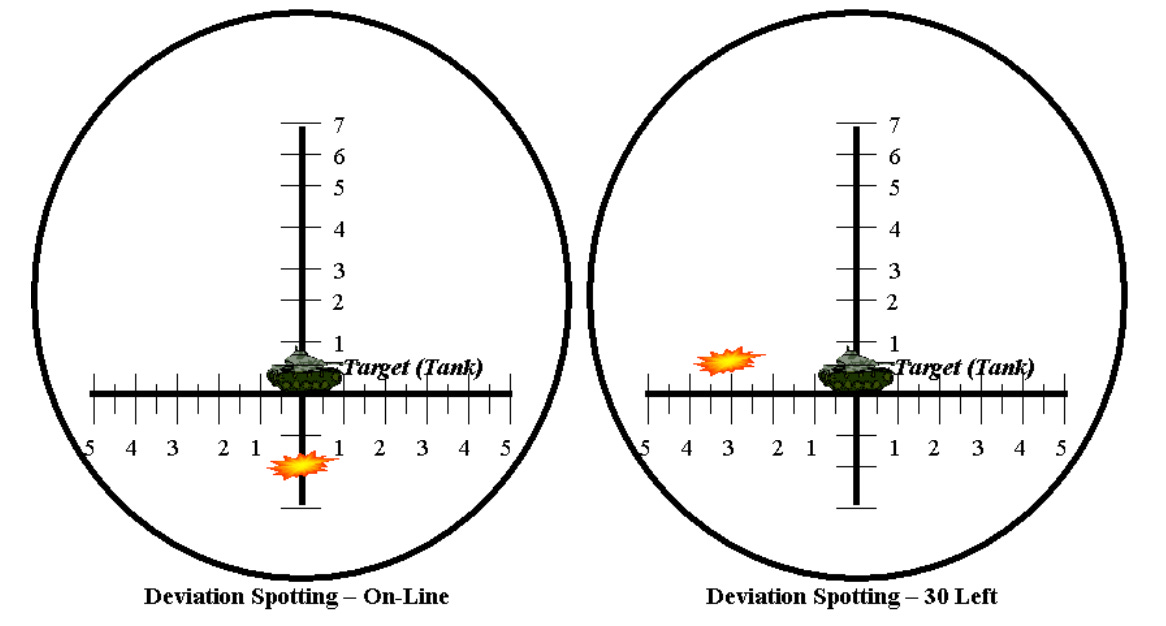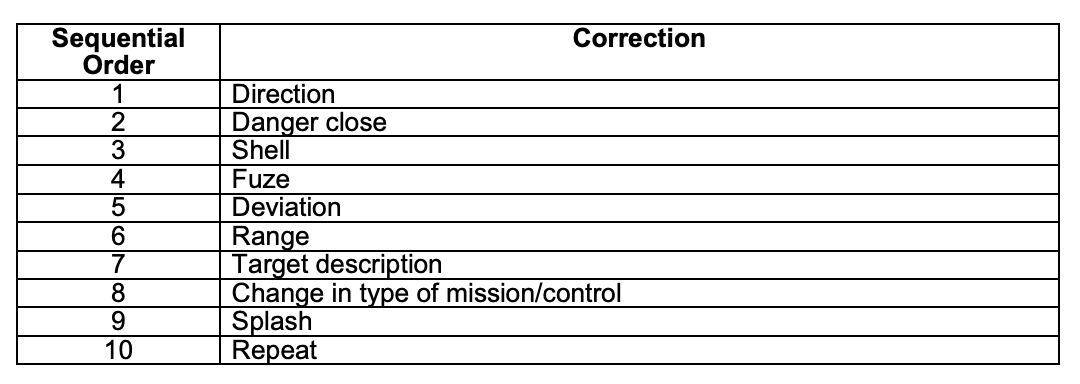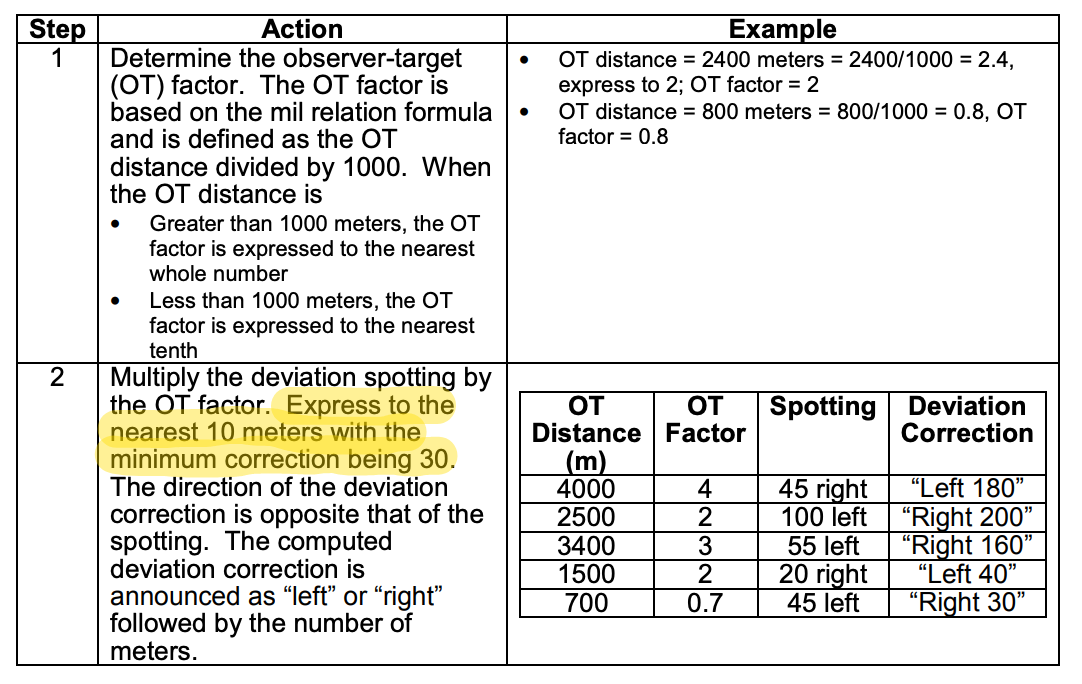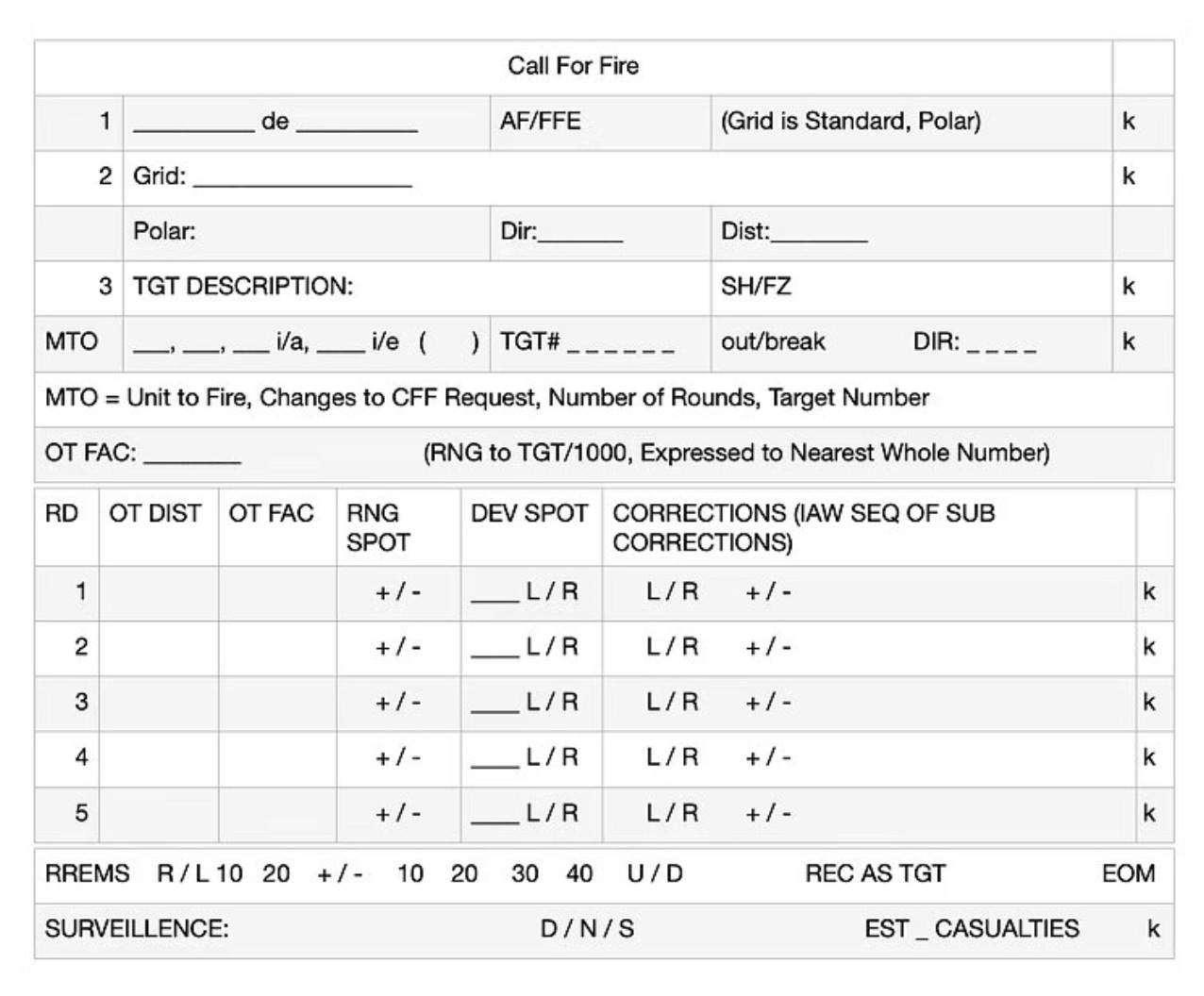Teaching the Basics of Call for Fire
The following material should be covered when teaching a class on the basics of call for fire (CFF).
This class will cover:
The five rules for CFF.
The WERM rule.
The CFF Transmission.
The Message to Observer.
Reports Upon Firing.
Adjustments of Fire.
Ending a Fire Mission.
On Suppressive Fire Missions.
On Bracketing.
[Author’s note: if you notice any discrepancies in the below information, please send a message or leave a comment noting where corrections are needed.]
Five Rules:
(1) Plot Yourself on the Map
Send POSREP to the Fire Direction Center (FDC).
Update POSREP every time you move.
(2) Get Direction to Target
Using lensatic compass, determine direction magnetic to the target.
Convert direction magnetic to grid using declination diagram (apply +/- the GM Angle). This gives us our Observer-Target (OT) Direction, and is always expressed to the nearest 10 mils grid and transmitted with four digits.
Draw line from your current position through expected location of target, giving us our observer target line (OTL).
(3) Estimate Distance to Target
Estimate distance to target along your observer target line (OTL) using key features, key terrain, known points, previous or recorded targets.
Utilize terrain association and known units of measurement (i.e. football fields).
(4) Calculate OT Factor
Divide distance by 1000: if less than 1.0, then round to nearest tenth (i.e. 0.9); if over 1.0, then round to nearest whole number (i.e. 2.2 becomes 2.0) and if it ends in 5, round to nearest whole even number (i.e. 1.5 becomes 2.0, 2.5 becomes 2.0).
OT Factor is used for subsequent corrections IOT convert from mils (as spotted in the M22 binos) to meters on the deck, which we then pass to the FDC for corrections.
(5) Plot Target on the Map
Recorded and registered targets will be maintained on map for future use.
If you record a target upon completion of a RREMS statement, ask for a replot grid (which takes into accounts all adjustments and corrections made).
The WERM Rule
Whether you are a forward observer (FO) or in charge of a support by fire unit, you need to calculate:
Range to target in meters.
Width of target in meters.
Distance from target to friendlies, a secondary target, or a direct fire support control measure (DFSCM) in mils.
Say you want to find the distance between Objective A and Objective B (diagram below). The WERM rule allows you, the FO, to plug in known variables (width in meters and mils) to solve for an unknown variable (range in meters to target), i.e. range estimation.
Or, say you need to identify an MSL for maneuver — you would use the WERM Rule to find out how many mils away that position would be. Then, you will use your optics to identify a spot on the deck you can talk your unit on to.
“WERM” stands for “width equals range in meters (divided by 1000) multiplied by mils.”
From the perspective of the FO, an angle of 1 mil (M = 1) separates Objectives A and B.
At a range of 2,000 meters (R = 2000)
W = (R/1000) (M)
W = (2000/1000) (1)
W = 2 Meters
Therefore, the lateral distance is 2 meters (W = 2).
From the perspective of an FO, an angle of 300 mils separates Objectives A and B.
At a range of 2,000 meters
W = (2,000/1,000) (300)
W = (2) (300)
W = 600 meters
Therefore, the lateral distance is 600 meters (W = 600).
Now, given 30 mils @ 3,000 meters, what is the width in meters between Objective A and B? The answer is 90 meters.
The CFF Transmission
Once you have determined the above data, you are ready to CFF. Note that a CFF is a request, not an order, as the FDC will determine the necessary adjustments to your fire mission. Furthermore, your fire mission is likely one of many the FDC is simultaneously coordinating. The only exception is if your fire mission is a priority target: i.e. a planned target (with determined type and amount of munitions) where firing units, when not engaged, will set the priority target data on their guns and lay on that target. The maneuver commander designates priority targets, and these can be shifted or changed as the supporting unit moves. A firing unit can be assigned a priority target or a final protective fire (FPF), but not both.
The CFF consists of six elements in three transmissions, with a break and a read back after each transmission.
First transmission example:
Second transmission example (target location, using grid or polar methods):
Note that OT distance is expressed to the nearest 100 meters.
Third transmission (target description, method of engagement, method of fire and control):
Target description:
Type of target (troops, supply dump, trucks)
Target activity (digging in, assembly area)
Number of elements in the target (squad, three trucks)
Degree of protection (in the open, in fighting holes, in bunkers with overhead cover)
Method of engagement:
Danger close (mortar/artillery rounds within 600 meters of friendly troops, NGF within 750 meters of friendly troops)
Ammunition type
i/a or i/e — in adjust or in effect (in effect refers to which rounds will be fired during the fire for effect stage)
Volume of fire
High angle (if terrain/obstacles restrict the standard, flatter trajectory), or low angle — requesting Max Ordnance means the FO is requesting the highest point
Methods of fire and control:
Request Splash = FDC informs FO when round is 5 seconds from detonation
FWR = fire when ready
AMC = at my command
Cannot Observe = FO does not have line of sight due to terrain, weather, obstructions
TOT = time on target = the unit times its fire so that the initial round strikes the target at the time specified by the FO. For example, “TOT 45” (rounds impact at 45 minutes past the hour).
Continued Illum — firing unit continuously fires illum rounds before previous ones burn out IOT maintain constant illum
Coordinated Illum — firing unit coordinates illum rounds with HE rounds IOT maximize effects. Types of coordinated illum include: before HE (lights up target), with HE (coincide with HE impact), and after HE (IOT assess effects).
Sheaf — types include parallel, converged, open, or special (linear, circular)
If you make errors during the transmission, you announce “correction,” and then transmit the correct data.
The Message to Observer (MTO)
After receiving the CFF request, the FDC will determine how to attack the target. The MTO will contain:
Unit(s) to fire.
Changes to the CFF.
Number of rounds.
Target number.
After you receive the MTO, you (the FO) read back the MTO verbatim. When firing a grid mission, you will include your direction to the target (in mils, rounded to the nearest 10) after the target number.
FDC: Message to observer, T, VT in effect, four rounds, target number AA 7732, over.
FO: Message to observer, T, VT in effect, four rounds, target number AA 7732, direction: 5500, out.
Reports Upon Firing
The FDC will send two reports during a fire mission.
Shot — the FDC is letting the FO after it has fired each round i/a.
Splash — when requested. This allows the FO to remain under cover/concealment for as long as possible, until he needs to observe effects.
You, as the FO, read back each report to the FDC.
Adjustments of Fire
After the initial round bursts, “spottings” and “corrections” are made. Time is of the essence IOT prevent the enemy from egressing.
Spottings are what you see, and include range and deviation:
Range spottings: short, range correct, range over, range doubtful (definite spotting cannot be made).
Deviation spottings: # of mils left, # of mils right, on line.
Corrections: after you make your initial spottings, you now need to make corrections. This is what you say over the radio. Correction are sent in meters, and in the reverse order of the spottings (range, then deviation): i.e. deviation first, range second.
The correct sequence of corrections looks like:
Direction is the key element for adjustment of rounds, and should be made in the first correction if the original direction changes by 100 mils or more.
The standard corrections are (4) and (5), i.e. Deviation and Range.
How to calculate Deviation Corrections:
Remember the rule, “if it ends in 5, round to the nearest even #?” Say you observed a round landing left 35 meters of the target, at a distance of 2600 meters. Your OT factor would be 3.0, and your correction should be right 105 meters. However, deviation corrections are expressed to the nearest 10 meters, with the minimum correction being 30 meters. If your correction is right 105, do you round up to 110, or down to 100 (both are even numbers)? The answer is to look at the first two digits in the numbers (11 and 10), and then choose the even number out of this pair, i.e. 10. Therefore, your deviation correction should be right 100.
Looking at the template, after the FDC has transmitted the message to observer (MTO), you will see OT Factor. This OT Factor is our (range to target / 1000) and is expressed to the nearest whole, even number. When making corrects, you must multiply them by the OT Factor.
Rules on OT Factor: if is is below 1.0, round to nearest tenth. If above 1.0, round to nearest whole number. If it ends in .5, round to the nearest even number.
Ex: OT distance of 1700 —> OT factor of 1.7 —> round to nearest whole number —> 2.0 .
Ex: OT distance of 1500 —> OT factor of 1.5 —> round to nearest whole number —> 2.0 (ends in 5, nearest even).
How to calculate Range Corrections:
The goal of range corrections is to enter the FFE phase as soon as possible. Range corrections consist of the following commands:
“Add (number of meters)” to move burst away from the FO
“Drop (number of meters)”to move burst closer to the FO
Range corrections are transmitted in multiples of 100 meters with the smallest correction being 100 meters. However, a 50-meter correction is used when entering fire for effect. The four methods of conducting range corrections are:
Hasty bracketing
On-round adjustment
Creeping fire
Successive bracketing
Successive bracketing is the creation of a bracket over and short of the target using the range bracketing guide below. Once a bracket has been established, subsequent range corrections are split in half, always moving the next burst toward the target. The FO continues this process until a 100-meter bracket is established around the target. He then adds or drops 50 (with a deviation correction as required) and enters the fire for effect phase.
Entering the Fire for Effect Phase:
The fire for effect phase is entered:
When the deviation and range are correct (adjusting round has effects on target), i.e. “Fire for effect, over.”
If effective fire will result when the 100-meter bracket is split, i.e. “Right 30, add 50, fire for effect, over.”
Following Fire for Effect. The FO analyzes the results of the fire for effect. The situation may require additional rounds to be fired on the same location or on a different location:
Ending a Fire Mission:
On achieving the effects desired on the target, the FO should transmit an end of mission statement to the firing unit. Four items are included in the end of mission or RREMS statement:
Refinement (sent in increments of 10 meters, may be less than 30 meters).
Record as target (if the FO wants the target plotted for future use, he applies the refinement, conducts a replot, and announces the adjusted grid).
End of Mission (this terminates the mission).
Surveillance: number, type, (destroyed, neutralized, suppressed), estimated number of casualties.
On Suppressive Fires
Suppressive fire missions take on two forms:
Delivered as an immediate suppression mission on (A) a planned target or (B) on a target of opportunity for a friendly unit under fire.
Delivered as a suppression mission on a planned target that is not currently active.
We must remember the purpose of suppression — IOT allow maneuver to do something. Since immediate suppression and suppression missions both yield suppressive results, these fires can allow:
Maneuver to close on the target;
Position the FO to AF on the target; or
Bypass the target all together.
(1) Immediate suppression missions normally require a minimum volume of fire. Unit SOP will establish:
The type of ammunition;
Units to fire; and
Volume.
For example: one mortar platoon, one round of HE/PD, one round of HE/VT.
This CFF transmission is sent in one transmission consisting of:
Observer ID;
WARN-O “immediate suppression”; and
Target location.
There is no MTO or RREMS.
Example:
FO: “This is W2P, immediate suppression, grid 221 432, over.”
FDC: “W2P, this is R2S, immediate suppression, grid 220 432, out.”
(2) Suppression missions normally consist of:
Observer ID;
WARN-O “suppress”;
Target number of planned target; and
Duration and rate of fire.
Example:
FO: “R2S, this is W2P, suppress AB3104, four minutes, four shells per minute, over.”
FDC: “W2P, this is R2S, suppress AB3104, four minutes, four shells per minute, out.”
On Bracketing:
As we just discussed, during AF mission you can use successive bracketing because it is “the only technique that mathematically guarantees you will have effects on target.” However, successive bracketing has its disadvantages. There are three alternate techniques for IDF: hasty bracketing, one round adjustments, and creeping fire.
(1) Hasty bracketing — due to the loss of surprise after firing the first round, successive bracketing (with multiple adjustments required) might result is decreased effectiveness. Therefore, an FO can use an initial bracket as a “yardstick” to determine the necessary correction and enter FFE phase faster. This depends upon:
Nature of the target;
Terrain;
Firing unit’s proficiency; and
FO’s experience.
(2) One round adjustments — you don’t need a bracket with this technique. Instead, the FO:
Spots the location of the first round;
Calculates and transmits a correction that is necessary to move the next burst onto target; and
FFE.
This technique can be used when:
Time has priority;
FO has a laser range finder;
Continued adjustments may endanger the FO.
(3) Creeping fire — this allows the FO to make range corrections by creeping the rounds closer to the target instead of bracketing or making large corrections.
In danger close situations. FO must keep in mind the position of friendly troops. Creeping fires would be applicable in situations where “lost rounds” are likely, ex: when the FO doesn’t have eyes on impact sight, when weather or terrain obscures FO’s LOS.
Ex: An FO wants to adjust rounds onto a target location on the topographic crest of a hill, so he chooses creeping corrections in 100M increments which move the rounds closer toward friendly forces until he sees them land on top the hill.
Sources:
Simplified CFF Template:


